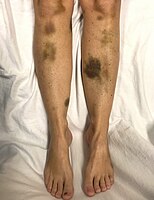
Photo from wikipedia
The aim of this study was to explore the clinical characteristics and treatment of acquired thrombotic thrombocytopenic purpura (TTP). The clinical manifestations, laboratory findings, differential diagnoses, therapeutic methods, and prognosis… Click to show full abstract
The aim of this study was to explore the clinical characteristics and treatment of acquired thrombotic thrombocytopenic purpura (TTP). The clinical manifestations, laboratory findings, differential diagnoses, therapeutic methods, and prognosis of 55 patients with acquired TTP were retrospectively analyzed. Among the 55 TTP patients, 17 were males and 38 were females, with a mean age of 40 ± 15 years. Twenty‐one patients had the Triad syndrome, which included neurological syndromes, microangiopathic hemolytic anemia, and thrombocytopenia. Twenty‐three patients had the Quinary syndrome, which included fever, microangiopathic hemolytic anemia, thrombocytopenia, renal insufficiency, and neurological symptoms. Twenty‐eight patients received the measurement for a disintegrin and metalloprotease with a thrombospondin type 1 motif, member 13 (ADAMTS13) activity and 23 patients had <10% of the normal range. ADAMTS13 inhibitor was tested in 20 patients and was positive in 18 patients. Both ADAMTS13 activity and ADAMTS13 inhibitor were examined in 20 patients and 90% of the patients showed double positive results. The treatment methods included plasma exchange, glucocorticoids, rituximab, immunosuppressants, and intravenous immunoglobulin. Thirty‐three patients survived, and 22 patients died. Plasma exchange improved the remission rate from 16.7% to 65.3% (P = .022). The combined immunosuppressive therapy based on plasma exchange and glucocorticoids raised the remission rate from 43.8% to 75.8%. Most of acquired TTP patients had the Triad syndrome or the Quinary syndrome. A high proportion of TTP patients had ADAMTS13 activity reduction and ADAMTS13 inhibitor positivity. Plasma exchange and immunosuppressive therapy may improve the prognosis of this disease.
Journal Title: Therapeutic Apheresis and Dialysis
Year Published: 2020
Link to full text (if available)
Share on Social Media: Sign Up to like & get
recommendations!